
CBO прогнозирует рост долга США на 24 триллиона долларов в течение следующего десятилетия, а затем это становится намного хуже.
Бюджетное управление Конгресса может утверждать, что оно аполитично и/или двупартийно, но на самом деле у них мало оговорок в том, чтобы бросить под автобус любого политика (политиков), которые не рассматриваются как часть внутреннего круга истеблишмента, и «кухня потопит» их со всеми накопленными финансовыми проблемами, которые накопились в США. Этот политик является Дональд Трамп, Тот, кто собирается инаугурироваться в качестве 47-го президента США, и кто скоро увидит, что долг США - уже на смехотворных 36,2 триллиона долларов - действительно взорвется во время его второй администрации, несмотря на любимый проект Маска DOGE.
Согласно последнему бюджету CBO и экономическим прогнозам на десятилетие 2025-2035 гг. Безнадежно и становится хуже Несмотря на то, что бюджетное ведомство не использует эти термины, оно все равно приближается.
Хотя экономическая картина, представленная CBO, вряд ли шокирует, хотя и нелепа, как всегда. В ближайшее десятилетие ожидается нулевая рецессия Когда CBO прогнозирует рост ВВП на 1,8% в годовом исчислении, при этом инфляция магически плоская на уровне 2,0%, уровень безработицы липкий 4,4% и 3,2% ставки по фондам (в переводе на 3,8% доходность 10 лет) ...
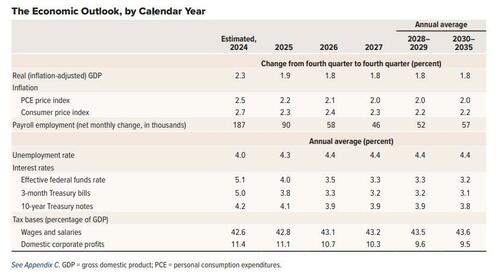
Это становится более захватывающим, когда мы смотрим на то, как будет финансироваться весь этот рост. И ответ, конечно, заключается в том, что в нестабильных дефицитах на триллионы больше, хотя, по мнению CBO, они, возможно, устойчивы, поскольку они никогда не заканчиваются.
Начиная с прогноза дефицита, CBO ожидает, что дефицит федерального бюджета в 2025 году составит 1,9 триллиона долларов, что к 2035 году вырастет до 2,7 триллиона долларов. И хотя он составляет 6,2% ВВП в 2025 году, а затем падает до 5,2% к 2027 году, поскольку доходы растут быстрее, чем расходы, эта умеренно выгодная тенденция быстро меняется, и в последующие годы расходы снова увеличиваются быстрее, чем доходы, а к 2035 году дефицит снова равен 6,1% ВВП, число, которое, по данным CBO, составляет 6,1% ВВП. Это значительно больше, чем 3,8 процента, которые дефициты в среднем за последние 50 лет." Само собой разумеется, что фактическое число дефицита будет намного, намного больше, потому что даже скромная рецессия обеспечит всплеск государственных расходов (то есть гораздо больший дефицит, финансируемый за счет долга), что, однако, не приведет к более быстрому росту.
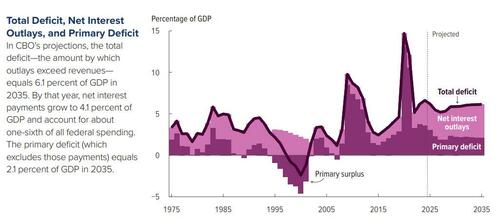
Становится лучше. В попытке заманить в ловушку Трампа, который очень расширит срок действия TCJA или снижение налогов Трампа, CBO достаточно забавно сокращает свой долгосрочный прогноз дефицита на 1 миллиард долларов, но не из-за более высокого роста или чего-то подобного, а потому, что он прогнозирует «увеличение прогнозируемых доходов от индивидуальных подоходных налогов». Законодательные изменения и технические (то есть ни экономические, ни законодательные) изменения увеличили прогнозируемый дефицит." В результате совокупный дефицит с 2025-2034 годов, как ожидается, снизится на $1 трлн, с $22,1 трлн до $21,1 трлн.
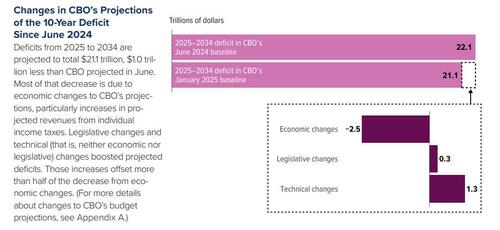
Таким образом, через год, когда будет продлено снижение налогов Трампом, CBO бросит книгу на Трампа и обвинит его, когда он снова пересмотрит свой прогноз дефицита, резко повысив его.
Что касается реальной причины, по которой дефицит США вот-вот станет экспоненциальным, имеет мало общего с налогами, и все, что связано со стратосферными уровнями долга США, или, скорее, с процентами по этому долгу, мы находим, что, хотя в течение следующих 3 лет все более или менее нормально, они идут вертикально, а именно:
Федеральные расходы в 2025 году составят $7,0 трлн, или 23,3% ВВП. Они остаются близкими к этому уровню до 2028 года, а затем растут, достигнув 24,4 процента ВВП в 2035 году (если скорректировать, чтобы исключить влияние сдвигов в сроках некоторых платежей). Основными причинами этого роста являются рост расходов на социальное обеспечение и медицинское обслуживание и рост чистых процентных расходов. "
К сожалению, нет такого эффекта хоккейной палочки для доходов правительства США, которые в 2025 году составят 5,2 триллиона долларов или 17,1% ВВП, а затем вырастут до 18,2% ВВП к 2027 году, что, согласно CBO, «из-за запланированного истечения срока действия положений налогового акта 2017 года», который, очевидно, не истечет и вместо этого будет продлен, то есть доходы не будут увеличиваться, и хотя CBO знает это, он вместо этого будет ждать 6-12 месяцев, прежде чем позволить молотку упасть в своем следующем, гораздо более уродливом прогнозе.
Но даже без налогового акта 2017 года CBO прогнозирует, что доходы в виде доли ВВП затем уменьшатся в течение следующих двух лет, упав до 17,9% в 2029 году и до 18,3% в 2035 году. На самом деле, это число будет намного ниже, возможно, около 15%, если не сказать хуже, из-за продления налоговых льгот Трампа. Следующий прогноз CBO будет существенно хуже нынешнего.
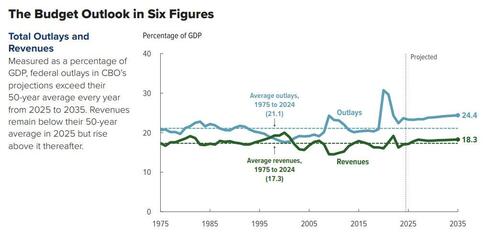
Увы, это тоже катастрофа, и нужно смотреть не дальше, чем прогноз CBO по долгам, чтобы увидеть это. Это связано с тем, что в то время как долг принадлежит общественности (что удобно исключает долг, используемый для финансирования социального обеспечения).В настоящее время он составляет 28,2 триллиона долларов, это число почти удвоится к 2035 году, когда ожидается, что он достигнет 52,1 триллиона долларов.
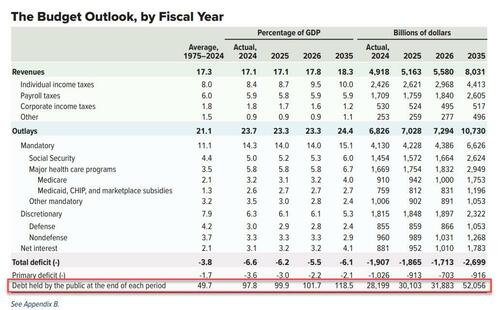
Но подождите, разве долг не увеличится только по мере роста ВВП, при этом относительное соотношение улучшится? На самом деле нет, потому что, как показывает печально известная «карта обреченности» CBO, поскольку долг, удерживаемый общественностью, растет каждый год, он делает это более быстрыми темпами, чем ВВП; на самом деле, с 2025 по 2035 год долг / ВВП растет со 100% до 118%, сумма, которая, как признает CBO, является «высокой».больше, чем когда-либо в истории страны. "
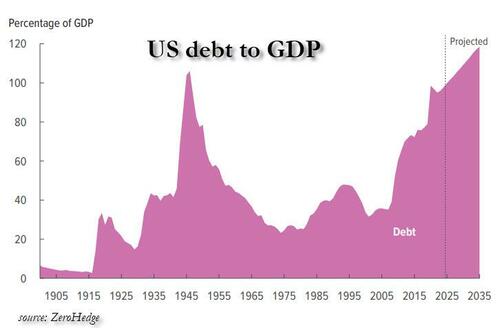
Теперь причина, по которой CBO опубликовал доклад, в котором наблюдалось скромное улучшение фискальной картины США в течение следующего десятилетия, заключается не в том, что фискальная картина США на самом деле улучшается, а в том, чтобы заманить Трампа и республиканцев. Как отмечает ABC, «анализ рисует трудную картину для новой республиканской администрации, стремящейся к сокращению налогов таким образом, чтобы еще больше увеличить дефицит, если они также не сочетаются с серьезным сокращением расходов». Действительно, предлагаемое Трампом продление его налоговых сокращений 2017 года, срок которых истекает после этого года, наряду с новыми сокращениями, может легко привести к снижению налогов. В четверг его кандидат на пост министра финансов Скотт Бессент предупредил, что экономика может рухнуть без них.
«У нас нет проблем с доходами в США», — настаивал Бессент на слушаниях по его утверждению. «У нас проблема с расходами. "
Он прав, но еще большая проблема заключается в том, что сокращение любых расходов, будь то дискреционные или обязательные, приведет к беспрецедентному экономическому опустошению для страны, которая привыкла выдавать долги и тратить их как пьяный моряк.
В то время как налоговые поступления как доля от общей экономики США близки к 50-летнему среднему показателю, государственные расходы готовы продолжать расти, в основном из-за беспрецедентных валовых процентных расходов в размере 1,2 триллиона долларов, число которых почти наверняка никогда больше не снизится, потому что даже если процентные ставки действительно ненадолго упадут, общая сумма долга просто продолжит расти, более чем компенсируя любое снижение ставки. Между тем, дискреционные расходы на национальную безопасность и социальные программы в следующем году составят 1,85 триллиона долларов. У CBO уже есть расходы в этих категориях на нисходящей траектории, поскольку дискреционные расходы будут равны 5,3% ВВП, по сравнению со средним показателем за полвека 7,9%.
КБО Режиссер: Phillip Свагель заявил журналистам на пресс-конференции в пятницу, что чистые процентные расходы являются основным источником дефицита и «По прогнозам, в ближайшие годы чистые процентные расходы будут аналогичны суммам дискреционных расходов на оборону или не оборону.«Программы».
И все это, конечно, без рецессии и демографической картины, которая остается неизменной; увы, оба предположения смехотворны.
При старении населения государственные расходы будут в значительной степени увеличиваться из-за социального обеспечения и Medicare — двух программ, популярных среди избирателей, которые многие республиканцы и демократы пообещали защищать, несмотря на явные признаки того, что они находятся на неустойчивом пути.
Свагель сказал. «Мы уже являемся стареющим обществом, и старение нашего общества приводит к обязательным расходам. "
«Поскольку американские женщины в более позднем возрасте ждут рождения детей и имеют их меньше, изменение рождаемости иногда ускоряет эту модель старения нашего общества», — сказал он.
Майкл Петерсон (Michael Peterson), генеральный директор фонда Питера Г. Петерсона (Peter G. Peterson Foundation), который, помимо прочего, отслеживает федеральный долг, сказал в своем заявлении, что, поскольку законодатели рассматривают диапазон истекающей налоговой политики в конце года, они должны взять на себя обязательство, по крайней мере, «не наносить фискального вреда». "
«Они должны избегать бюджетных уловок и основывать свои предположения на нейтральных, беспартийных оценках, подобных этой от CBO», — сказал он.
К сожалению для США, сейчас слишком поздно менять неизбежный исход существования, которое было вызвано непомерными расходами, финансируемыми за счет долга. Действительно, когда дело доходит до нормализации или «не причинения финансового вреда», что корабль отплыл, и столько, сколько мы хотели бы, чтобы там был какой-то счастливый конец, мы в ужасе от того, что произойдет, когда самые яркие умы в комнате признают, что Департамент эффективности правительства (DOGE) был провалом, и что ничто не может предотвратить неизбежный крах США.
Подробнее в полном прогнозе CBO.
Тайлер Дерден
Фри, 01/17/2025 - 16:40







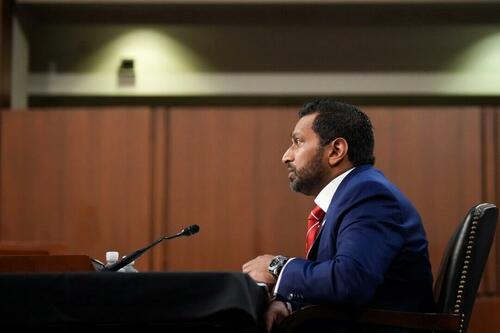


![Sąd: Mieszkanie 191.500 zł. Zachowki 31.916,66 zł i 10.638,88 zł. Obliczenia. Wzory [Przykład]](https://g.infor.pl/p/_files/38265000/podwyzki-38264590.jpg)







